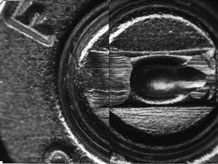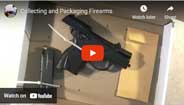|
View in browser: https://www.crime-scene-investigator.net/newsletter/1024.html
|
||
|
OCTOBER 2024 | ||
| ||
|
Featured Video Presentation
|
||
|
This video demonstrates the proper way to make a pistol safe and the proper way to collect and package a firearm. |
||
|
This Month's Featured Resource on the Crime Scene Investigator Network Website
|
||

ATF Police Officer's Guide to Recovered Firearms U.S. Department of Justice This guide is designed for Police Officers and includes the following topics: Firearms Safety, Required Markings, How To Identify Firearms, Tips For Firearms Queries Using Mobile NCIC Terminals, Trace All Recovered Firearms, Persons Prohibited by Federal Law from Possessing Firearms,Questions to Ask Unlawful Firearms Possessors, and Visual Guide to Firearms. |
New CSI and Forensic Job Announcements
|
|
|
The most comprehensive listing of Crime Scene Investigation and Forensic To be notified of job openings as they are posted, follow us on Twitter: Job Posting Alerts |
||
|
Crime Scene Specialist Trainee
Kauai Police Department, Kauai, Hawaii, USA Final Filing Date: October 23, 2024 Receives initial orientation and training in searching for, recovering, preserving, and marking physical evidence at crime and traffic accident scenes; receives orientation in preparing detailed evidence reports and exhibits for court ... <View complete job listing> |
||
|
Crime Scene Technician Trainee
Louisville Metro Police Department, Louisville, Kentucky, USA Final Filing Date: November 6, 2024 The purpose of this position is to learn the techniques, procedures, tools, equipment and materials used in the collection, preservation, processing and presentation of physical evidence. <View complete job listing> |
||
|
Crime Scene Technician
Ashwaubenon Police Department, Ashwaubenon, Wisconsin, USA Final Filing Date: November 8, 2024 Responsible for technical work which involves locating, documenting, collecting, preserving, processing, and disposing of physical evidence and found property <View complete job listing> |
||
|
Crime Scene Technician
Amarillo Police Department, Amarillo, Texas, USA Final Filing Date: Open until filled Photograph crime scenes; process crime scenes for fingerprints; search and collect evidence from crime scenes; book evidence; diagram crime scenes; prepare reports; maintain equipment; teach identification techniques to field officers and other Crime Scene Technicians; operates SPEX and AFIS system; testify in court; <View complete job listing> |
||
 |
||
|
Evidence Specialist
Seminole County Sheriff's Office, Sanford, Florida, USA Final Filing Date: October 30, 2024 This position involves technical work responsible for the receipt, custody, documentation, storage, and disposal of evidence or other items housed by the Forensic Laboratory Services Division. <View complete job listing> |
||
|
Latent Print Examiner
Anne Arundel County Police Department, Annapolis, Maryland, USA Final Filing Date: October 28, 2024 Processes evidence for the recovery of latent prints using chemical and other techniques. Compares latent prints to known inked prints or utilizes the Maryland Automated Fingerprint Identification System for possible suspect identification. <View complete job listing> |
||
|
Forensic Toxicologist
Tarrant County Medical Examiner, Fort Worth, Texas, USA Final Filing Date: October 29, 2024 Performs accessioning, analysis, and evaluation of evidence utilizing standardized and industry acceptable techniques. Analyzes evidence (biological or other) for the presence of drugs, alcohol, and other analytes and reports results. <View complete job listing> |
||
|
Deputy Coroner
Sacramento County Coroner's Office, Sacramento, California, USA Final Filing Date: November 13, 2024 The Deputy Coroner Level I/II conducts investigations to determine the jurisdiction, circumstances, manner and cause of deaths which occur within the jurisdiction of the Sacramento County's Coroner's Office. <View complete job listing> |
||
|
Search for more job listings in Crime Scene Investigations and Forensics To be notified of job openings as they are posted, follow us on Twitter: Job Posting Alerts |
||
|
Other Resources on the Crime Scene Investigator Network Website
|
||
|
Not Subscribed to this Newsletter?
|
||
|
If you are not subscribed to this newsletter, you may subscribe our website by clicking here: SUBSCRIBE. |
||
|
To Unsubscribe
|
||
|
To unsubscribe from future e-mail alerts, please click here: UNSUBSCRIBE Copyright ©2024 Crime Scene Resources Crime Scene Investigator Network |

 The examination process typically begins when an examiner receives a suspect firearm, along with bullets (the projectiles) and spent cartridge cases recovered from a crime scene. The gun is test-fired in order to recover bullets and cartridge cases that serve as controls, or better, comparison samples. That is, these test-fired specimens will be compared at multiple levels with the specimens submitted from the crime scene.
The examination process typically begins when an examiner receives a suspect firearm, along with bullets (the projectiles) and spent cartridge cases recovered from a crime scene. The gun is test-fired in order to recover bullets and cartridge cases that serve as controls, or better, comparison samples. That is, these test-fired specimens will be compared at multiple levels with the specimens submitted from the crime scene.


